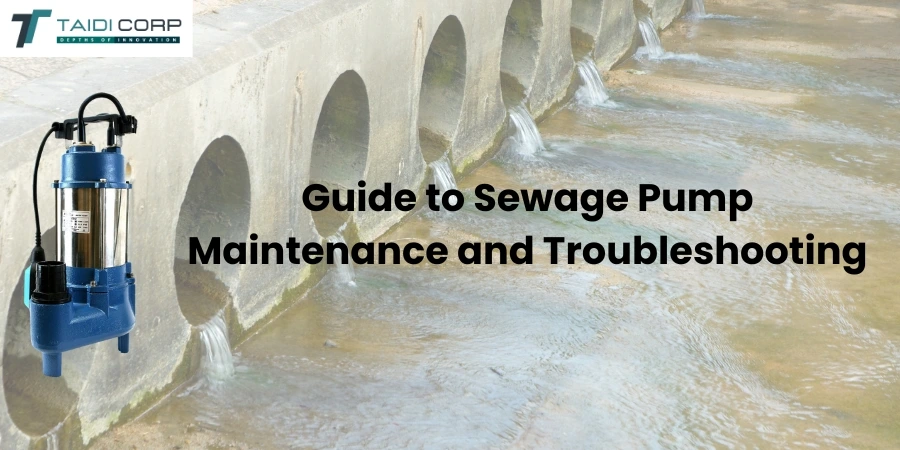
Maintaining a reliable sewage pump system is essential for every homeowner, property manager, DIY enthusiast, and plumbing professional. A well-maintained sewage pump ensures efficient wastewater management, preventing costly backups and repairs. This comprehensive guide will walk you through everything you need to know about sewage pump maintenance and troubleshooting, empowering you to keep your system running smoothly.
Introduction
Importance of Sewage Pump Maintenance
A sewage pump plays a crucial role in managing wastewater in your home or property. It transports sewage from lower levels, such as basements or crawl spaces, to the main sewer line or septic system. Regular sewage pump maintenance is vital to prevent pump failures, sewage backups, and expensive repairs. By staying proactive, you can ensure your sewage system operates efficiently and reliably.
Purpose of the Guide
This guide aims to provide detailed, practical steps and troubleshooting tips to help you maintain your sewage pump in optimal condition. Whether you’re a homeowner, property manager, DIY enthusiast, or plumbing professional, you’ll find valuable information to identify, prevent, and fix common issues with sewage pump systems, thereby extending their lifespan and performance.
Understanding How Sewage Pumps Work
Basic Components
Understanding the key parts of a sewage pump system is the first step in effective maintenance. Here are the main components:
- Motor: Powers the pump to move wastewater.
- Impeller: Rotates to push sewage through the discharge pipe.
- Float Switch: Activates the pump when wastewater reaches a certain level.
- Discharge Pipe: Carries wastewater to the main sewer line or septic system.
- Check Valve: Prevents backflow of sewage into the pump basin.
Visual: Diagram of a sewage pump system with labeled components.
How a Sewage Pump Operates
When wastewater enters the pump basin, the float switch detects the rising water level and activates the motor. The motor turns the impeller, which pushes the sewage through the discharge pipe into the main sewer line or septic system. Once the water level drops, the float switch deactivates the pump, stopping the flow of wastewater.
Regular Maintenance Tasks
Monthly Inspection
- Check the Pump and Basin: Look for debris, rust, or wear that could impede pump function.
- Test the Float Switch: Ensure it moves freely without any obstructions.
Visual: Step-by-step images for cleaning the basin and testing the float switch.
Quarterly Cleaning
- Clean the Pump Basin: Remove sludge, grease, and debris to prevent clogs.
- Inspect the Impeller: Remove any buildup or foreign objects that could affect performance.
Annual Professional Inspection
- Hire a Licensed Plumber: A professional can perform a thorough inspection of the pump, electrical connections, and discharge line, ensuring everything is in proper working order. For professional sewage pump inspection services, visit our All Products page.
Backup Battery Check (If Applicable)
- Test the Backup System: Ensure the battery is functioning correctly and replace it if necessary to maintain pump operation during power outages.
Common Sewage Pump Issues and How to Troubleshoot Them
Pump Not Turning On
Possible Causes:
- Faulty float switch
- Electrical problems
- Tripped breaker
Troubleshooting Steps:
- Check Power Supply: Ensure the pump is receiving electricity.
- Test the Float Switch: Replace if it’s not functioning properly.
- Reset the Breaker: If tripped, reset it and monitor for recurring issues.
Pump Running Continuously
Possible Causes:
- Stuck float switch
- Clogged discharge pipe
- Faulty check valve
Troubleshooting Steps:
- Adjust the Float Switch: Ensure it moves freely.
- Inspect the Discharge Line: Clear any blockages.
- Check the Check Valve: Replace if it’s not operating correctly.
Unusual Noises (Grinding or Rattling)
Possible Causes:
- Debris in the impeller
- Damaged bearings
- Loose motor components
Troubleshooting Steps:
- Clean the Impeller: Remove any debris.
- Inspect Motor and Bearings: Look for signs of damage.
- Tighten Loose Components: Secure any parts that are rattling.
Slow Drainage or Backups
Possible Causes:
- Clogged discharge pipe
- Inadequate pump capacity
- Faulty pump
Troubleshooting Steps:
- Clear the Discharge Line: Remove any obstructions.
- Check Pump Capacity: Ensure it matches system requirements.
- Replace the Pump: If it’s underperforming.
Frequent Short Cycling
Possible Causes:
- Float switch issues
- Incorrect pump size
- Small sump basin
Troubleshooting Steps:
- Adjust or Replace the Float Switch: Ensure proper operation.
- Verify Pump Size: Make sure it’s suitable for your system.
- Consider a Larger Basin: Prevent overloading during high demand.
Visual: Troubleshooting flowcharts for diagnosing common problems.
Advanced Troubleshooting Tips
Diagnosing Electrical Issues
- Safe Testing: Use a multimeter to check the power supply and connections.
- Motor Failure Signs: Look for burnt smells, unusual noises, or complete lack of operation.
- When to Call an Electrician: If you detect complex electrical problems, seek professional help.
Testing the Pump Capacity
- Measure Flow Rate: Use a bucket and timer to determine how much water the pump moves per minute.
- Compare to Specifications: Ensure the flow rate matches the pump’s rated capacity.
- Adjust or Replace: If underperforming, adjust settings or consider a new pump.
Checking for Airlocks
- Identify Airlocks: Signs include inefficient pump operation and irregular water flow.
- Clear Airlocks: Open the discharge pipe to release trapped air or use a priming pump.
When to Repair vs. Replace Your Sewage Pump
Signs It’s Time for Repair
- Minor issues like a faulty float switch
- Clogged impeller
- Small leaks
Signs It’s Time for Replacement
- Pump age over 7-10 years
- Frequent breakdowns
- Extensive rust or corrosion
- Major mechanical failures
Cost Considerations
- Repair Costs: Generally lower but depend on the issue’s severity.
- Replacement Costs: Higher upfront but may be more cost-effective in the long run if the pump is old or frequently failing.
- Weighing Options: Compare the costs of repairs against purchasing and installing a new pump.
Proactive Tips for Extending the Life of Your Sewage Pump
Proper Use
- Avoid Flushing Non-Biodegradable Items: Do not flush wipes, feminine hygiene products, or large food particles to prevent clogs.
Monitor Water Usage
- Manage High-Demand Periods: Prevent overloading by spreading out water use during peak times.
Install a Sump Alarm
- Early Warning System: Set up an alarm to notify you of high water levels or pump failures, allowing prompt action.
Professional Maintenance and Inspection Checklist
For a comprehensive professional inspection, ensure the following tasks are completed:
- Electrical Testing: Verify all connections and power supply.
- Pump Performance Evaluation: Assess flow rates and operational efficiency.
- System Calibration: Adjust settings for optimal performance.
- Component Inspection: Check the motor, impeller, float switch, and check valve for wear or damage.
FAQs
What should I do if my pump stops working suddenly?
First, check the power supply and ensure the pump is receiving electricity. Inspect the float switch and reset the breaker if necessary. If the issue persists, contact a professional plumber.
How often should I clean my sewage pump?
Perform monthly inspections and quarterly cleanings. Additionally, schedule an annual professional inspection to maintain optimal performance.
What is the typical lifespan of a sewage pump?
Most sewage pumps last between 7-10 years with proper maintenance. Factors like usage frequency and maintenance quality can affect longevity.
Can I install a sewage pump myself, or do I need a professional?
While some DIY enthusiasts can handle basic installations, it’s recommended to hire a licensed plumber to ensure proper installation and compliance with local codes.
Conclusion
Regular sewage pump maintenance and timely troubleshooting are essential for ensuring the efficient and reliable operation of your wastewater management system. By following the practical steps outlined in this guide, you can prevent common issues, extend the lifespan of your pump, and avoid costly repairs. Don’t hesitate to implement these tips and seek professional assistance for more complex problems.
We encourage you to share your experiences or ask questions in the comments below. For more detailed resources or professional services, visit our All Products page to explore additional options.
